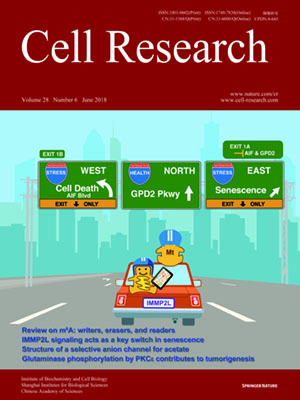
Volume 28, No 6, Jun 2018
ISSN: 1001-0602
EISSN: 1748-7838 2018
impact factor 17.848*
(Clarivate Analytics, 2019)
Volume 28 Issue 6, June 2018: 644-654
ORIGINAL ARTICLES
Succinate-acetate permease from Citrobacter koseri is an anion channel that unidirectionally translocates acetate
Biao Qiu 1,2, Bingqing Xia 3,9, Qingtong Zhou 4, Yan Lu 1,2, Miaomiao He 1,2, Kazuya Hasegawa 5, Zhiqiang Ma 6, Fengyu Zhang 7,Lichuan Gu 7, Qionglei Mao 3,9, Feng Wang 8, Suwen Zhao 1,4, Zhaobing Gao 3 and Jun Liao 1,2
1School of Life Science and Technology, ShanghaiTech University, Shanghai 201210, China; 2Institute of Biochemistry and Cell Biology, Chinese Academy of Sciences, 320
Yueyang Road, Shanghai 200031, China; 3CAS Key Laboratory of Receptor Research, State Key Laboratory of Drug Research, Shanghai Institute of Materia Medica, Chinese Academy of Sciences, Shanghai 201203, China; 4iHuman Institute, ShanghaiTech University, Shanghai 201210, China; 5Protein Crystal Analysis Division, Japan Synchrotron Radiation Research Institute, Hyogo 679-5198, Japan; 6Key Laboratory of Functional Molecular Engineering of Guangdong Province, School of Chemistry and Chemical Engineering, South China University of Technology, Guangzhou, Guangdong 510640, China; 7State Key Laboratory of Microbial Technology, Shandong University, Jinan,Shandong 250100, China; 8Wuxi Biortus Biosciences Co., Ltd, Wuxi, Jiangsu 214437, China and 9University of Chinese Academy of Sciences, 19A Yuquan Road, Beijing 100049,China
Correspondence: Correspondence: Zhaobing Gao (zbgao@simm.ac.cn) or Jun Liao (liaojun@shanghaitech.edu.cn)These authors contributed equally: Biao Qiu, Bingqing Xia.
Acetate is an important metabolite in metabolism and cell signaling. Succinate-Acetate Permease (SatP) superfamily proteins are known to be responsible for acetate transport across membranes, but the nature of this transport remains unknown. Here, we show that the SatP homolog from Citrobacter koseri (SatP_Ck) is an anion channel that can unidirectionally translocate acetate at rates of the order of ~107 ions/s. Crystal structures of SatP_Ck in complex with multiple acetates at 1.8 Å reveal that the acetate pathway consists of four acetate-binding sites aligned in a single file that are interrupted by three hydrophobic constrictions. The bound acetates at the four sites are each orientated differently. The acetate at the cytoplasmic vestibule is partially dehydrated, whereas those in the main pore body are fully dehydrated. Aromatic residues within the substrate pathway may coordinate translocation of acetates via anion-π interactions. SatP_Ck reveals a new type of selective anion channel and provides a structural and functional template for understanding organic anion transport.
https://doi.org/10.1038/s41422-018-0032-8
FULL TEXT | PDF
Browse 1180


